2015 York Christian Apocrypha Symposium: A Postmortem (Part 2)
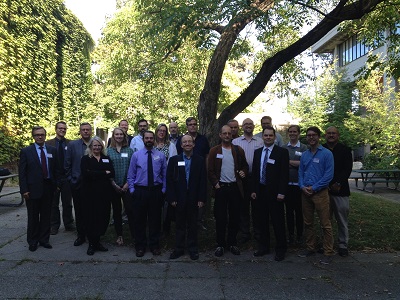 Day two of the Symposium began with a brief introduction in which Brent Landau and I discussed the history of the Symposium and the theme of this year’s gathering. Then our first session on the writing of early apocrypha kicked off with a paper by Stanley Porter (McMaster Divinity College) on “Lessons from the Papyri: What Apocryphal Gospel Fragments Reveal about the Textual Development of Early Christianity.” Porter’s expertise in NT text criticism generally and the editing of early fragments is widely acknowledged. Notable also is his recent work with Brent on a new introduction and translation of P.Oxy II 210 for the first volume of the More New Testament Apocrypha series. Porter mentioned that it is difficult to identify the precise nature of these “gospel fragments”—are they pieces of lengthy “gospel” texts? homilies? canonical gospel harmonies? or are they the remains of apotropaic texts (i.e., magical amulets)?
Day two of the Symposium began with a brief introduction in which Brent Landau and I discussed the history of the Symposium and the theme of this year’s gathering. Then our first session on the writing of early apocrypha kicked off with a paper by Stanley Porter (McMaster Divinity College) on “Lessons from the Papyri: What Apocryphal Gospel Fragments Reveal about the Textual Development of Early Christianity.” Porter’s expertise in NT text criticism generally and the editing of early fragments is widely acknowledged. Notable also is his recent work with Brent on a new introduction and translation of P.Oxy II 210 for the first volume of the More New Testament Apocrypha series. Porter mentioned that it is difficult to identify the precise nature of these “gospel fragments”—are they pieces of lengthy “gospel” texts? homilies? canonical gospel harmonies? or are they the remains of apotropaic texts (i.e., magical amulets)?
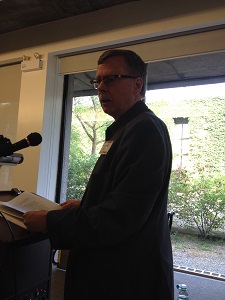
The answer may come closer to within our reach when the fragments are treated to complete critical editions based on new, in-person evaluation of the manuscripts, which Porter thinks is long overdue. Also still undetermined, Porter said, is how the texts were used by early Christian communities; “if these fragmentary Gospels were used in a liturgical fashion,” he writes in his paper, “they do not appear to have been used in the same way as scriptural readings of texts.” They were perhaps supplementary episodes, read for edification and further elaboration, but not as the scriptural text itself or as a substitute for it.” I wonder, though, how Porter arrived at this conclusion. How different are these fragments from NT gospel fragments? Is Porter (perhaps unconsciously) imposing a hierarchy on the evidence, with NT gospels necessarily occupying a superior place in the early period than non-canonical texts? Porter believes the NT gospels were composed prior to 70 CE; so, likely he thinks of them as acquiring widespread authority very early. This viewpoint may lie also behind his statement that the fragments “reinforce a relatively stable text of the Greek New Testament by the time of their composition.” I find this statement puzzling—there is no “Greek New Testament” to speak of in the first few centuries; regardless, the gospel fragments only show contact with the NT gospels, not the entire NT. Perhaps his point is that the fragments’ apparent knowledge of the Synoptics and John (for example, in the blending we see of these texts in P. Egerton 2) demonstrates acknowledgement of all four gospels as scripture. Both Bart Ehrman and I questioned Porter on this issue, but his response did not resolve the ambiguity.
Some of the questions posed by Porter were answered, at least in part, by Ross Ponder’s (University of Texas in Austin) paper, “Reconsidering P. Oxy. 5072: Creation and Reception, Visual and Physical Features.” Like Porter, Ponder contributed a translation and introduction to MNTA on, naturally, P. Oxy. 5072, which contains a telling of the exorcism of the Gadarene demoniac and a conversation between Jesus and his disciples. This manuscript contains several reader’s aids (paragraphos marker, diaieresis, and slashes) which, Ponder said, “could mean that it was intended for liturgical/public reading.” The Gadarene demoniac story has the qualities of a harmony, leading me to ask Ponder at what point can we identify texts such as these as apocryphal gospels? Caroline Schroeder suggested that the exorcism story may indicate that P. Oxy. 5072 is an apotropaic text. And Bart Ehrman joked to Stanley Porter that its contents suggest that this apocryphal gospel fragment, at least, demonstrates the fluidity of the “Greek New Testament,” not stability.
After the break Brent Landau presented his paper, “Under the Influence (of the Magi): Did Hallucinogens Play a Role in the Inspired Composition of the Pseudepigraphic Revelation of the Magi?” As my partner in forming the program of the Symposium, Brent always planned on attending the event, but he became a presenter after one of our other presenters had to withdraw. The paper went right to the heart of the issue of composition—i.e., the contents of the text may have originated in visions. Landau argues that the text contains “references to visionary experiences that some group of early Christians underwent” and that the star-food mentioned in the text “is best explained by positing that the early Christians behind [the text] had ingested, quite possibly in a ritual manner, a hallucinogenic substance of some sort.” The theory places Landau among what he calls “entheogenists,” a group of scholars studying hallucinogens in religious ritual. A “plausible candidate” for the hallucinogen in Rev. Magi is a special kind of mushroom.
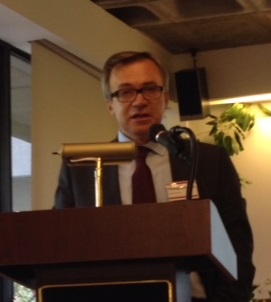
Finishing up the session was Pierluigi Piovanelli’s (University of Ottawa) “What Has Pseudepigraphy to Do with Forgery? Reflections on the Cases of the Acts of Paul, the Apocalypse of Paul (Visio Pauli), and the Zohar.” Piovanelli touched on a number of topics that were taken up again in later discussions. First, he noted that accusations of forgery, such as Tertullian’s indictment of a certain presbyter for the creation of the Acts of Paul, result from the accuser’s distaste of the text’s contents. Tertullian branded the text a forgery because he objected to its support of women performing baptism and teaching. Second, Piovanelli drew attention to a medieval forgery: the Zohar, attributed to Rabbi Aquiva, but apparently composed in the fourteenth century by Moses de Léon, and drew upon the words of Gershom Scholem to defend the practice of pseudepigraphy: “Pseudepigraphy is far removed from forgery. The mark of immorality, which is inseparable from falsehood, does not stain it, and for this reason it has always been admitted as a legitimate category of religious literature of the highest moral order. The historian of religion in particular has no cause to express moral condemnation of the pseudepigraphist” (Major Trends in Jewish Mysticism, 204). Leading the response, Bart Ehrman asked, “are you saying that the writers of texts like the Acts of Paul are not trying to deceive?” To which Piovanelli replied, “No, they see themselves as inspired” and writing in the “school of thought” of the person whose name appears as author of the text. Ehrman and Piovanelli then discussed the “we” section in the canonical Acts, which Piovanelli explained as a “historiographical device, not a mark of forgery.” Ehrman ended the exchange saying, “We have a lot to disagree about.”
The afternoon comprised two sessions, the first, called “Reusing and Recycling Christian Apocrypha,” featured papers by Brandon W. Hawk (Rhode Island College) and Timothy Pettipiece (University of Ottawa and Carleton University). Hawk, our token medievalist, spoke on “‘Cherries at command’: Preaching the Gospel of Pseudo-Matthew in Anglo-Saxon England.” The paper focused on the use of the Pseudo-Matthew in two sources: an Old English sermon designated Vercelli 6 (created ca. 959-988), which contains an enumeration of miracles heralding Jesus’ birth (including golden rings around the sun and the Roman emperor forgiving all people) followed by excerpts from Pseudo-Matthew on Jesus’ birth, the slaughter of the innocents, and the flight to Egypt, and the eleventh-century Sacramentary of Robert Jumièges, which contains 13 illuminations, two of which feature iconography related to Pseudo-Matthew. Christian Apocrypha scholars are suckers for iconography; so the discussion focused more on the Sacramentary than Vercelli 6. It in interesting to see how the iconography related to the infancy material differs between the West (based on Pseudo-Matthew) and the East (based on the Protevangelium of James).
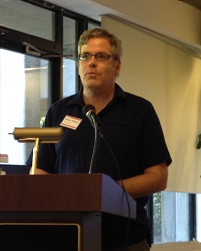
Pettipiece, our token Manichaeism scholar, spoke on “Manichaean Redaction of the Secret Book of John.” Pettipiece lamented the neglect in scholarship of the Manichean codices found at Medinet Madi in 1929; compared to the similar discovery at Nag Hammadi, Pettipiece said, the “editing and publication of these texts has proceeded at a somewhat glacial pace.” His paper is part of a larger project on a Manichaean reading of the Nag Hammadi texts; describing the specific goal of the present paper, Pettipiece writes, “I will take the text which the codex compilers seemed to have been most interested in—the Secret Book of John—and examine it through a Manichean lens in order to determine what connections might have existed between the two bodies of early Christian literature.” As a result, he sees “substantial evidence of both Manichean reception and redaction.” Similar evidence is found, he says, in other Codex II texts, such as On the Origin of the World and the Hypostasis of the Archons, but cautions that some Nag Hammadi texts contain anti-Manichean statements. Perhaps this should be taken as further indication that the Nag Hammadi codices, though published together, derive from multiple discovery sites.
Session three focused on modern apocrypha. I started the session with “Apocrypha and Forgeries: Lessons from the ‘Lost Gospels’ of the Nineteenth Century.” I first became interested in modern apocrypha when thinking about theories of forgery for Secret Mark. I wondered how evidence for the text would stack up against other texts meant to be modern creations, asking what proof led scholars of these other texts to declare them forgeries and how does evidence for Secret Mark compare? I widened the discussion to include the Gospel of Jesus’ Wife and said a little also on Richard J. Arthur’s theory that the Gospel of Judas is a modern forgery created by members of the National Geographic team who prepared the first critical edition of the text. Stanley Porter asked why this theory did not catch on since, as I describe in the paper, Arthur invokes the same kind of evidence against this text (suspicious knowledge of a known copy of a text from antiquity, an awareness of modern issues in Christianity, and it reads like a patchwork assembly of other texts); I can only assume it did not receive support because of the solid reputations of the National Geographic team—there was no Smith among them. Among the conclusions in my paper are that Christian Apocrypha scholars should avoid the term forgery when examining modern texts. Since virtually all apocrypha have false attributions or tell stories from the distant past as if they were witnesses to the events, we should use temporal markers instead—GJW is not a forgery then, but a “modern” or “contemporary” apocryphon. Also, we should ignore the voices of those who say these modern texts are not worthy of study; like all texts, they tell us something about the time of their composition and some remain in use by modern religious movements. The discussion after my presentation took up another point made in the paper, that forgery theories begin with dislike of the text’s content. Mark Goodacre took issue with this and said that I misrepresented Stephen Carlson’s arguments on Secret Mark—Carlson did not include in his argument that Smith was gay, Goodacre said; rather, Carlson simply called him a “lifelong bachelor.” Caroline Schroeder countered that this term is a well-known euphemism for a homosexual man.
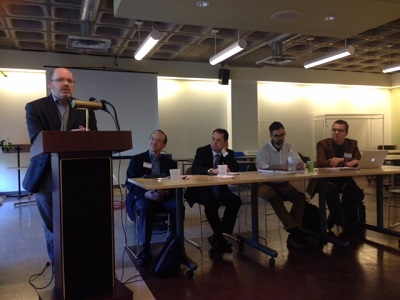
Bradley Rice (McGill University) followed with a look at one particular modern apocryphon in his paper, “The Apocryphal Tale of Jesus’ Journey to India: Nicolas Notovitch and the Life of Saint Issa Revisited.” It is an excellent, detailed study of the text, its origins, and its impact. One item that struck me as interesting is the text’s soft approach on Jewish culpability in Jesus’ death and the connection to the Jewish experience of late nineteenth-century Russia; this reinforces the view that these texts have much to tell us about their time of composition. Rice concludes, “As we continue to investigate modern apocrypha in the years to come, maybe the question ought not be ‘What do they say about Jesus?’ but rather ‘What do they say about us?’” Pierluigi Piovanelli, a strong proponent of studying modern apocrypha, but also a defender of the forgery theory for Secret Mark, mentioned in the discussion that he has the ability to forge a text in Ethiopic, but not the desire. Remember this the next time Piovanelli writes about a new Ethiopic apocryphon!
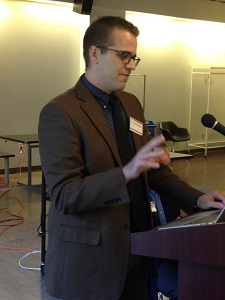
Eric Vanden Eykel (Ferrum College) followed Rice with “Expanding the Apocryphal Corpus: Some ‘Novel’ Suggestions.” Having joined the program rather late, Vanden Eykel was able to provide us with just the beginning of a paper but expanded it somewhat in the presentation. He looks at four works of fiction that share some things in common with ancient apocrypha: Bruce Longenecker’s The Lost Letters of Pergamum, Chistopher Moore’s Lamb: The Gospel According to Biff, Colm Toíbín’s The Testament of Mary, and Naomi Alderman’s The Liar’s Gospel. Vanden Eykel’s excerpts from the novels, particularly Moore’s comedic Lamb, were well-received, particularly towards the end of a long day of presentations. He still has work to do on the methodological implications of these novels, but he did mention that studying the texts is “boring” since there is little mystery as to their authors’ identities, the novels’ sources, etc., and that, despite being fictional, reading these texts does affect one’s understanding of Jesus and early Christian history. He wondered if ancient apocrypha had the same affect on early Christians; indeed, that is precisely the fear of heresy hunters, both ancient and modern.
The session ended with Scott Brown’s “Behind the Seven Veils, II: Assessing Clement of Alexandria’s Knowledge of the Mystic Gospel of Mark,” a sequel to his paper from the 2011 symposium. This new paper gives thought to the interpretation of Secret Mark that Clement promises to deliver at the end of his letter to Theodore. Brown draws upon Clement’s unchallenged works to see how Clement would have interpreted the longer version of Mark’s gospel. “If this is not possible,” Brown says, “then we have reason to doubt that Clement read and expounded this story himself, and, by extension, that he authored the letter.” Brown finds that “the richness and consistency of the resulting spiritual interpretation and its concordance with both every facet of Clement’s program of perfection and the life setting of the mystic gospel described in the latter…satisfy any reasonable standard of proof that Clement knew the mystic gospel and therefore wrote the Letter to Theodore.” Brown started his presentation stating that this is “probably my last paper on Secret Mark” and asked if anyone was convinced by it. His question was greeted with an uncomfortable silence, but no-one else in the room shared Brown’s deep knowledge of Clement, making it difficult to interact with the paper. The discussion turned quickly to arguments about authenticity, with Stanley Porter commenting that he spoke to Morton Smith once about the response to his work on the text and Smith voiced “disbelief” about the mounting accusations of forgery. Brown called attention also to notes made by Smith in his own copy of Clement of Alexandria and the Secret Gospel of Mark demonstrating that he had never considered what Clement’s allegorical reading of the text might be. The archive of Smith’s books and notes reveal much about Smith’s work on the text, and indicate unequivocally to me that he did not create the text.
Up next: Bart Ehrman’s keynote address.
P.S. For James McGrath’s detailed account of day one of the Symposium see his posts on Exploring Our Matrix (Session 1 Part 1, Session 1 Part 2, Session 2, and Session 3) for Timo Panaanen’s see Salainen evankelista.
